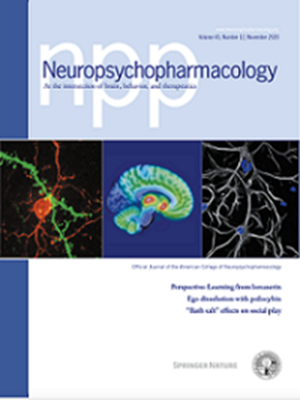Identifying brain-penetrant small-molecule modulators of human microglia using a cellular model of synaptic pruning
IF 6.6
1区 医学
Q1 NEUROSCIENCES
引用次数: 0
Abstract
Microglia dysregulation is implicated across a range of neurodevelopmental and neurodegenerative disorders, making their modulation a promising therapeutic target. Using PBMC-derived induced microglia-like cells (piMGLCs) in a scalable assay, we screened 489 CNS-penetrant compounds for modulation of microglial phagocytosis of human synaptosomes in a validated assay for microglia-mediated synaptic pruning. Compounds from the library that reduced phagocytosis by ≥2 standard deviations across the library without cytotoxicity were validated in secondary screens, with 28 of them further confirmed to reduce phagocytosis by 50% or more. These compounds comprise a wide range of therapeutic classes with different mechanisms of action, including immunosuppressants, kinase inhibitors, antipsychotics, and epigenetic modulators. Image-based morphological measurements were calculated to measure the degree of ramified vs. ameboid morphotypes as an indicator of activation state. Additionally, transcriptomic profiling indicated divergent effects on cell signaling, metabolism, activation, and actin dynamics across confirmed compounds. In particular, multiple CNS-penetrant small molecules with prior FDA approval or demonstration of safety in vivo demonstrated modulatory effects on microglia. For example, identified drugs such as the tyrosine kinase inhibitors lapatinib, alectinib, and lazertinib and the epigenetic modulator vorinostat have been approved for various cancer treatments and are being investigated for other indications; however, they have not been extensively studied in patients for neurodevelopmental and neurodegenerative disorders. These potential disease-modifying agents represent high-priority candidates for repositioning studies in neurodevelopmental, neuroinflammatory, or neurodegenerative disorders.

利用突触修剪细胞模型鉴定人类小胶质细胞的脑渗透小分子调节剂。
小胶质细胞失调涉及一系列神经发育和神经退行性疾病,使其调节成为一个有希望的治疗靶点。我们利用pbmc衍生的诱导小胶质样细胞(piMGLCs)进行了一项可扩展的实验,筛选了489种cns渗透化合物,用于调节人突触体的小胶质吞噬,并进行了小胶质介导的突触修剪实验。在二级筛选中验证了文库中使整个文库中吞噬能力降低≥2个标准差且无细胞毒性的化合物,其中28个化合物进一步证实可使吞噬能力降低50%或更多。这些化合物包括具有不同作用机制的广泛治疗类,包括免疫抑制剂、激酶抑制剂、抗精神病药和表观遗传调节剂。计算基于图像的形态学测量,以测量分叉与变形虫形态的程度,作为激活状态的指标。此外,转录组学分析表明,已证实的化合物对细胞信号传导、代谢、激活和肌动蛋白动力学的影响存在差异。特别是,经过FDA批准或体内安全性证明的多种cns渗透小分子对小胶质细胞具有调节作用。例如,已确定的药物,如酪氨酸激酶抑制剂拉帕替尼、阿勒替尼和拉泽替尼,以及表观遗传调节剂伏立诺他已被批准用于各种癌症治疗,并正在研究其他适应症;然而,它们尚未在神经发育和神经退行性疾病患者中进行广泛研究。这些潜在的疾病调节剂是神经发育、神经炎症或神经退行性疾病重新定位研究的优先候选药物。
本文章由计算机程序翻译,如有差异,请以英文原文为准。
求助全文
约1分钟内获得全文
求助全文
来源期刊

Neuropsychopharmacology
医学-精神病学
CiteScore
15.00
自引率
2.60%
发文量
240
审稿时长
2 months
期刊介绍:
Neuropsychopharmacology is a reputable international scientific journal that serves as the official publication of the American College of Neuropsychopharmacology (ACNP). The journal's primary focus is on research that enhances our knowledge of the brain and behavior, with a particular emphasis on the molecular, cellular, physiological, and psychological aspects of substances that affect the central nervous system (CNS). It also aims to identify new molecular targets for the development of future drugs.
The journal prioritizes original research reports, but it also welcomes mini-reviews and perspectives, which are often solicited by the editorial office. These types of articles provide valuable insights and syntheses of current research trends and future directions in the field of neuroscience and pharmacology.
 求助内容:
求助内容: 应助结果提醒方式:
应助结果提醒方式:


